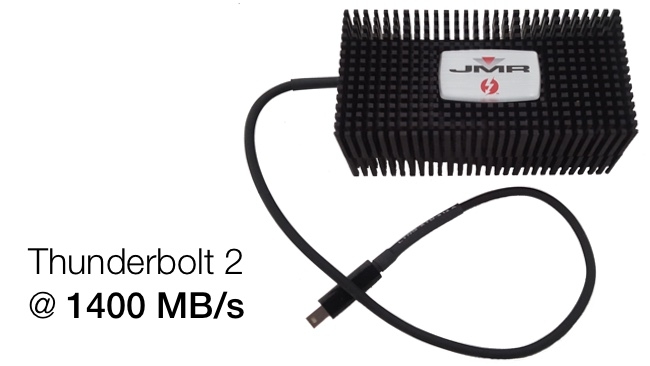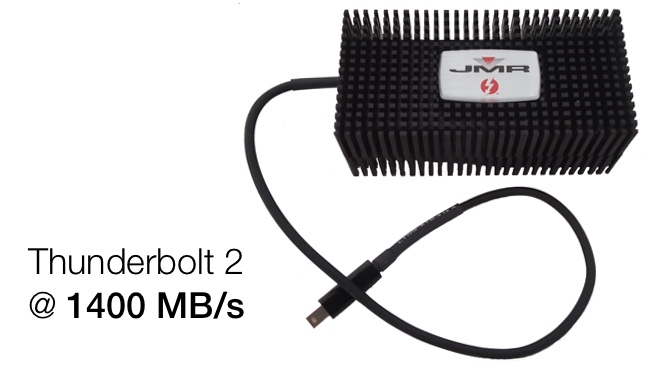
 JMR Lightning LTNG-XTD
JMR Lightning LTNG-XTD
Upstart JMR Electronics is making waves with a portable SSD that leverages Thunderbolt 2 connectivity and a unique cooling solution to achieve impressive speeds.
JMR Electronics Inc. of Chatsworth (just north of Los Angeles), has announced a portable Thunderbolt SSD called the JMR Lightning LTNG-XTD with claimed performance figures that are quite astounding.
Super speed
Using a Thunderbolt 2 interface permits a read speed up to 1400 MB/sec and write speed up to 1200 MB/sec, with the added bonus that it is bus-powered and does not require an external power supply.Compatible with all Thunderbolt 2 compliant host devices, including the Mac Pro, this drive provides data transfers at four times the speed of USB 3.0. That is 20Gb/sec vs. 5Gb/sec, courtesy of the Thunderbolt 2 controller and interface.
Outline Specifications of the JMR Lightning LTNG-XTD portable Thunderbolt SSD:
- 256GB Storage Capacity
- Portable Solid State Drive
- Up to 1400 MB/s Read
- Up to 1200 MB/s Write
- Dimensions: 133.4mm x 66.7mm x 44.5mm
- Attached Thunderbolt cable: 18" long (457mm)
- Weight: 590g
The hardware is based on a Samsung M.2 PCIe Gen3 SSD SM951, which is specified at 2150MB/sec sequential reads, 1200MB/sec sequential writes and 90K IOPS. Added to that, we have an Intel Falcon Ridge Thunderbolt controller with firmware that is part of the Intel Falcon Ridge 2C Reference Design. The latest Apple Macs include a driver for this device, but JMR had to develop a Windows driver to round off development.
Reasonable heft
So why, you may wonder, is the LTNG-XTD such a beefy piece of hardware? Thunderbolt has a spec limit of 10W and the LTNG-XTD dissipates 9.2W on writes, so there is no power available for a cooling solution. As a result, JMR was obliged to develop a housing or enclosure that would cool the drive passively and provide a fair degree of protection from knocks and bumps. The result is a machined and anodized aluminium enclosure with enormous exposed surface area that allows the SSD to operate continuous reads and writes at elevated ambient temperatures up to 40C.
Reducing the surface area even slightly can result in overheating the SSD device (it's rated 70C max). The heat sink cannot be removed and the SSD device inside is installed under pressure using conductive silpads to create better thermal conduction to the machined flat interior surfaces.
Premium value
The LTNG-XTD is available initially at 256GB storage capacity, with 512GB and 1TB models due shortly. The 256GB model is on sale in the USA at retailers for around $649. While that may sound fairly steep, the LTNG-XTD is a unique storage product that came about as a result of an Intel competition. Intel was looking for a vendor to develop and market a Thunderbolt SSD, much like an overgrown thumb drive, but with much higher capacity and much faster data transfer rates thanks to the 20Gb/sec Thunderbolt 2 bus. To compete, a vendor would need to have a working model of the product at the NAB SHOW 2015 last April, then complete Intel-Apple Certification for Thunderbolt, then build production units and have them stocked by at least one global distributor. JMR hit these targets and is now due to collect some sort of prize from Intel.
JMR tells us it applied for a U.S. Patent on LTNG-XTD in April 2015 and "expect it to be issued some time in 2016 as the patent office typically takes 12-18 months to review and approve applications," so it is currently 'Patent Pending'.
Tags: Technology


Comments